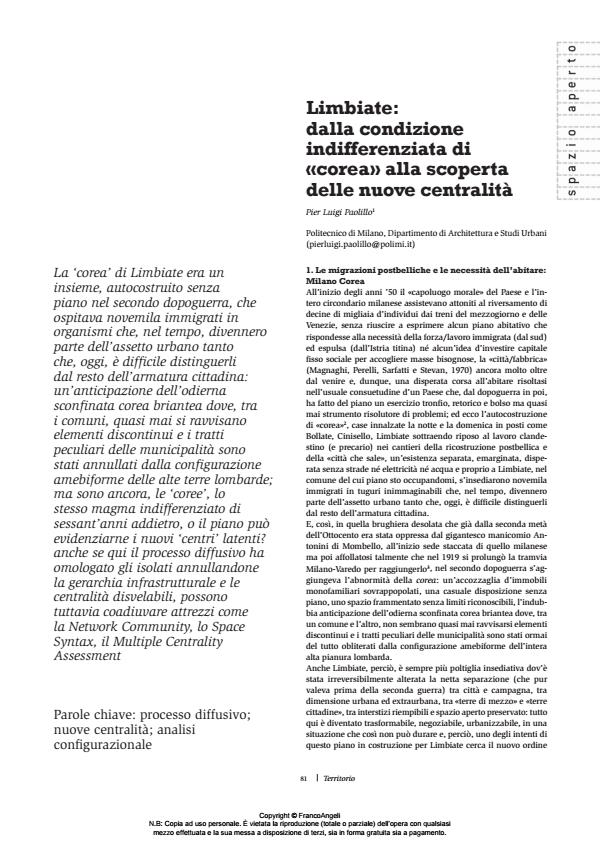Limbiate: dalla condizione indifferenziata di «corea» alla scoperta delle nuove centralità
Titolo Rivista TERRITORIO
Autori/Curatori Pier Luigi Paolillo
Anno di pubblicazione 2013 Fascicolo 2013/66
Lingua Italiano Numero pagine 11 P. 81-91 Dimensione file 1010 KB
DOI 10.3280/TR2013-066017
Il DOI è il codice a barre della proprietà intellettuale: per saperne di più
clicca qui
Qui sotto puoi vedere in anteprima la prima pagina di questo articolo.
Se questo articolo ti interessa, lo puoi acquistare (e scaricare in formato pdf) seguendo le facili indicazioni per acquistare il download credit. Acquista Download Credits per scaricare questo Articolo in formato PDF

FrancoAngeli è membro della Publishers International Linking Association, Inc (PILA)associazione indipendente e non profit per facilitare (attraverso i servizi tecnologici implementati da CrossRef.org) l’accesso degli studiosi ai contenuti digitali nelle pubblicazioni professionali e scientifiche
The ‘corea’ of Limbiate was a self built-entity, with no plan, that arose in the post-war years and housed 9,000 immigrants in structures which over the years became part of the urban fabric to the extent that today it is difficult to distinguish them from the rest of the urban build. It was an anticipation of the unbounded ‘corea’ of the Brianza today where you almost never see elements of discontinuity between the towns and villages and the particular features of municipalities have been obliterated by the amoeba like configuration of the Lombard uplands. However, are they still the ‘coree’, the same undifferentiated magma of 60 years ago, or can the plan trace the new latent ‘centres’? Even if here the process of diffusion has standardised the blocks of buildings eliminating the infrastructural hierarchy and the clearly discernible centralities, tools like ‘network community’, ‘space syntax’ and ‘multiple centrality assessment’ can nevertheless assist.
Parole chiave:Diffusion process; new centralities; configuration analysis
- Computational Science and Its Applications -- ICCSA 2015 Pier Luigi Paolillo, Umberto Baresi, pp.440 (ISBN:978-3-319-21469-6)
- Computational Science and Its Applications – ICCSA 2014 Pier Luigi Paolillo, Massimo Rossati, Mattia Andrea Rudini, pp.125 (ISBN:978-3-319-09146-4)
Pier Luigi Paolillo, Limbiate: dalla condizione indifferenziata di «corea» alla scoperta delle nuove centralità in "TERRITORIO" 66/2013, pp 81-91, DOI: 10.3280/TR2013-066017